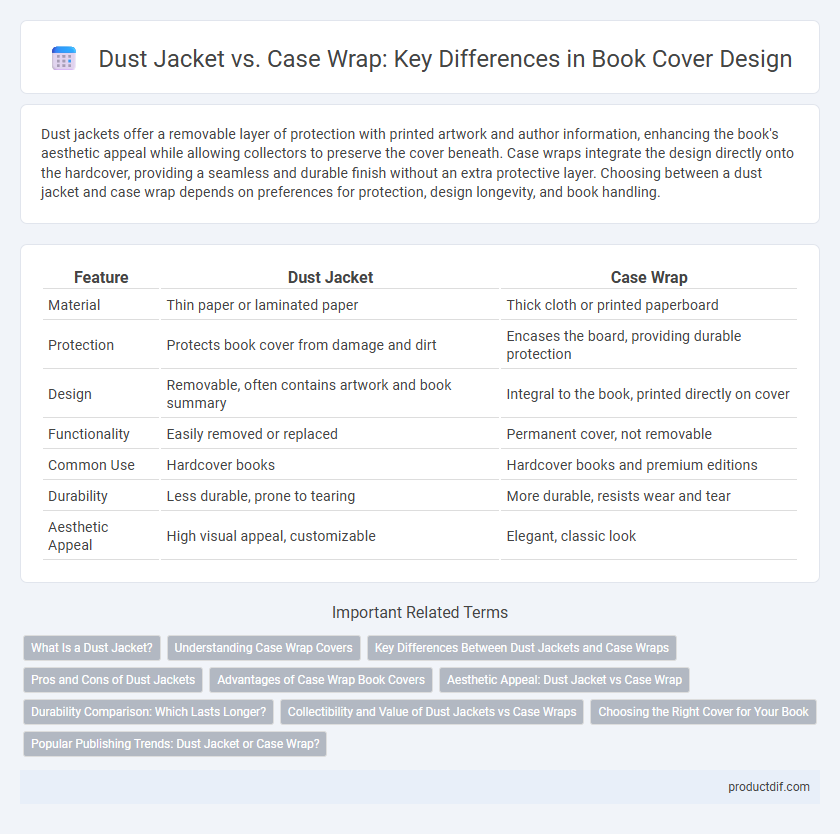Dust jackets offer a removable layer of protection with printed artwork and author information, enhancing the book's aesthetic appeal while allowing collectors to preserve the cover beneath. Case wraps integrate the design directly onto the hardcover, providing a seamless and durable finish without an extra protective layer. Choosing between a dust jacket and case wrap depends on preferences for protection, design longevity, and book handling.
Table of Comparison
| Feature | Dust Jacket | Case Wrap |
|---|---|---|
| Material | Thin paper or laminated paper | Thick cloth or printed paperboard |
| Protection | Protects book cover from damage and dirt | Encases the board, providing durable protection |
| Design | Removable, often contains artwork and book summary | Integral to the book, printed directly on cover |
| Functionality | Easily removed or replaced | Permanent cover, not removable |
| Common Use | Hardcover books | Hardcover books and premium editions |
| Durability | Less durable, prone to tearing | More durable, resists wear and tear |
| Aesthetic Appeal | High visual appeal, customizable | Elegant, classic look |
What Is a Dust Jacket?
A dust jacket is a removable paper cover wrapped around the hardcover of a book, designed to protect the binding and provide space for artwork, summaries, and author information. It typically features vibrant printing and glossy finishes to enhance visual appeal and can be easily removed without damaging the book. Dust jackets also serve as marketing tools, often including blurbs, reviews, and barcode labels essential for retail presentation.
Understanding Case Wrap Covers
Case wrap covers provide a durable and protective outer layer for hardcover books, integrating the book's design directly onto the board beneath a clear laminate. Unlike dust jackets, which are removable paper covers often prone to wear, case wraps enhance longevity and reduce the risk of damage during handling and shelving. This method offers cost-effective production with a sleek, polished appearance, making it ideal for libraries and books intended for frequent use.
Key Differences Between Dust Jackets and Case Wraps
Dust jackets are removable paper covers wrapped around a hardcover book, featuring printed designs and protective functions, while case wraps involve the book's cover being printed directly onto the hardcover boards without an additional protective layer. Dust jackets allow for extra artwork, flaps for summaries or author bios, and can be replaced if damaged, whereas case wraps offer a streamlined, durable finish but lack these removable and detailed design elements. The key differences lie in their construction, protectiveness, customization options, and tactile experience for readers.
Pros and Cons of Dust Jackets
Dust jackets protect books from dust, scratches, and light damage while often featuring eye-catching artwork and marketing information, enhancing shelf appeal. However, they can be fragile, prone to tearing, and easily lost or damaged, decreasing their long-term durability compared to case wraps. Dust jackets also add extra production costs and require careful handling, making them less practical for heavily used or children's books.
Advantages of Case Wrap Book Covers
Case wrap book covers offer superior durability compared to dust jackets, providing seamless protection against wear and tear over time. The printed cover is integrated directly into the hardcover, allowing for vibrant, high-resolution artwork that enhances visual appeal without the risk of damage or loss. This design reduces production costs by eliminating the need for a separate dust jacket, making it a cost-effective choice for publishers seeking long-lasting, aesthetically pleasing book covers.
Aesthetic Appeal: Dust Jacket vs Case Wrap
Dust jackets offer a traditional aesthetic appeal with vibrant, high-quality artwork printed on glossy or matte paper, creating an eye-catching outer layer that enhances the book's visual identity. Case wraps integrate the cover design directly onto the hardcover, providing a sleek, seamless look without the need for a removable jacket, often featuring embossed or foil-stamped elements for added texture and luxury. Both options enhance shelf presence, with dust jackets allowing more design freedom and case wraps delivering durability and a modern minimalist style.
Durability Comparison: Which Lasts Longer?
Dust jackets offer moderate protection against dust and minor damage but are more prone to tears and creases over time compared to case wraps. Case wraps, also known as perfect-bound covers, provide enhanced durability by fully encasing the book's boards, resisting wear and maintaining structural integrity longer. For collectors and libraries prioritizing longevity, case wraps typically outperform dust jackets in durability and sustained aesthetics.
Collectibility and Value of Dust Jackets vs Case Wraps
Dust jackets significantly enhance a book's collectibility and market value due to their rarity and role in preserving the underlying binding, with first editions featuring intact jackets often fetching higher prices. Case wraps, although visually appealing and integral to modern hardcover designs, typically lack the historical significance and protection that contribute to elevated collector interest. Preservation of a dust jacket can directly influence a book's graded condition and desirability among collectors, making it a critical factor in valuation.
Choosing the Right Cover for Your Book
Selecting between a dust jacket and a case wrap hinges on protection and presentation needs; dust jackets offer detachable, decorative covers ideal for collectors, while case wraps provide durable, printed hard covers designed for long-term use. Consider the target audience and printing budget, as dust jackets allow easy customization and special finishes, whereas case wraps streamline production with integrated cover graphics. The decision impacts the book's market appeal, shelf durability, and overall aesthetic, making it essential to align the cover type with distribution channels and reader preferences.
Popular Publishing Trends: Dust Jacket or Case Wrap?
Dust jackets remain popular for their aesthetic appeal and protection, featuring vibrant artwork and author information that attracts readers. Case wraps, favored in modern publishing trends, offer cost-effective durability by printing directly onto the hardcover, creating a sleek and sturdy appearance. Publishers increasingly choose case wraps for large print runs due to lower production costs and resistance to wear compared to dust jackets.
Dust Jacket vs Case Wrap Infographic

 productdif.com
productdif.com